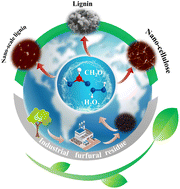Formic acid–hydrogen peroxide treatment of furfural residue for production of nanocellulose, lignin, and nano-scale lignin†
Abstract
Further utilization of furfural residue, an industrial solid waste, has been a long-term challenge because of its hostile properties that limit applications, such as strong acidity and high salinity. Herein, inspired by the pulping technology, an environmentally friendly system was proposed to separate cellulose and lignin from the furfural residue by treatment with formic acid–hydrogen peroxide (FA–H2O2), followed by ultrasound treatment, dilution, and high-speed centrifugation. The three products obtained are nanocellulose, precipitated lignin, and nano-scale lignin. Results showed that the FA–H2O2 system can extract lignin from the furfural residue effectively with high selectivity, but has negligible effect on cellulose extraction from the furfural residue. When the furfural residue (5 g) was treated with 40 mL FA and 16 mL H2O2, the remaining lignin content in the solid residue reached the lowest value (0.8 wt%), and the corresponding cellulose content was 88.0 wt%. The lignin structure obtained by the dilution–precipitation procedure was mainly p-hydroxyphenyl (H) with a molecular weight of 1093–1634 g mol−1, while the nano-scale lignin obtained from the supernatant by centrifugation was an oblate sphere, with a transverse size range of 332–511 nm and a thickness of 2–10 nm. Nanocellulose obtained by ultrasound treatment had a width of 15–55 nm, a length of 500–1000 nm, a zeta potential of −35 mV to −45 mV and a transmittance of 65%–90% at 800 nm. This method simply converts industrial furfural residue waste into high value-added nanoparticles and precipitates lignin, which increases the economic added value of the furfural residue and eliminates its pollution to the environment.



 Please wait while we load your content...
Please wait while we load your content...